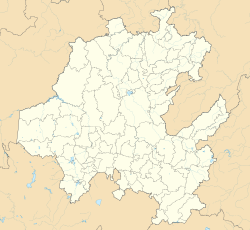The El Doctor Formation is a geologic formation in Mexico. It preserves fossils dating back to the Albian and Cenomanian stages of the Cretaceous period.[1] Ammonite fossils show that age of Late Albian is more likely.[2]
| El Doctor Formation | |
|---|---|
| Stratigraphic range: Albian-Cenomanian ~ | |
| Type | Formation |
| Sub-units | La Negra Member |
| Lithology | |
| Primary | Lime mudstone |
| Location | |
| Coordinates | 20°48′N 99°18′W / 20.8°N 99.3°W |
| Approximate paleocoordinates | 18°54′N 64°30′W / 18.9°N 64.5°W |
| Region | Hidalgo |
| Country | |
Description
editThe light grey micritic limestone sequence with intercalated black chert lenses was deposited in an open marine basin with a hypersaline and/or poorly oxygenated bottom.[1]
Fossil content
editThe formation has provided the following fossils:[1][3][4][5][2]
- Fish
- Squalicorax falcatus
- Ptychodus decurrens
- Rajiformes[6]
- Enchodus zimapanensis[7]
- Xeneichthys yanesi
- Heckelichthys preopercularis
- Motlayoichthys sergioi
- Nunaneichthys mexicanus
- Ichthyotringa mexicana
- Muhichthys cordobai
- Dalgoichthys tropicalis
- Handuichthys interopercularis
- Pseudomonocentris microspinosus
- Araripichthys sp.
- Vinctifer sp.
- Pachyrhizodus sp.
- cf. Tselfatia
- Pycnodontiformes
- Cladocyclidae
- Elopiformes
- Gonorhynchiformes
- Mawsoniidae[8]
- Arthropods
Ammonites
edit- Mortoniceras sp.
- Hamites aff. renzi
- Beudanticeras sp.
Echinoderms
editSee also
editReferences
edit- ^ a b c El Doctor Formation at Fossilworks.org
- ^ a b López-Palomino, Isabel; González-Rodríguez, Katia Adriana; Schultze, Hans-Peter; Palma-Ramírez, Arturo; Contreras-Cruz, Diana (2021-11-01). "Ammonites from the La Negra Facies (El Doctor Formation, late Albian) of the Muhi Quarry, Hidalgo, central Mexico". Journal of South American Earth Sciences. 111: 103400. Bibcode:2021JSAES.11103400L. doi:10.1016/j.jsames.2021.103400. ISSN 0895-9811.
- ^ Feldmann et al., 2007
- ^ Arratia, Gloria; González-Rodrígue, Katia (17 July 2024). "A New Intriguing Teleost from the Albian Muhi Quarry, Central Mexico, and Early Euteleostean Diversification". Diversity. 16 (7): 414. doi:10.3390/d16070414.
- ^ Rodríguez, Katia González; Fielitz, Christopher (2016). "CRETACEOUS OSTEICHTHYAN FISH ASSEMBLAGES FROM MEXICO". Cretaceous Period: Biotic Diversity and Biogeography. New Mexico Museum of Natural History and Science Bulletin. 71.
- ^ González-Rodríguez, K.A.; Espinosa-Arrubarrena, K.; González-Barba, G. (2013). "An overview of the Mexican fossil fish record" (PDF). In Arratia, G.; Schultze, H.-P.; Wilson, M.V.H. (eds.). Mesozoic Fishes 5 – Global Diversity and Evolution. München: Verlag Dr. Friedrich Pfeil. pp. 9–34. ISBN 978-3-89937-159-8.
- ^ Fielitz & González Rodríguez, 2010
- ^ Schultze, Hans-Peter; González-Rodríguez, Katia Adriana (2016-04-15). "Actinistian gular plates from the Cretaceous of Mexico and the problems assigning gular plates taxonomically". Fossil Record. 19 (2): 101–117. Bibcode:2016FossR..19..101S. doi:10.5194/fr-19-101-2016. ISSN 2193-0074.
- ^ a b Hegna et al., 2014
Bibliography
edit- Hegna, T. A.; Vega, F. J.; González Rodríguez, K. A. (2014), "First Mesozoic thylacocephalans (Arthropoda, Crustacea; Cretaceous) in the western hemisphere: new discoveries from the Muhi Quarry Lagerstätte", Journal of Paleontology, 88 (3): 606–616, Bibcode:2014JPal...88..606H, doi:10.1666/13-131
- Fielitz, C.; González Rodríguez, K. A. (2010), "A New Species of Enchodus (Aulopiformes: Enchodontidae) from the Cretaceous (Albian to Cenomanian) of Zimapán, Hidalgo, México", Journal of Vertebrate Paleontology, 30 (5): 1343–1351, Bibcode:2010JVPal..30.1343F, doi:10.1080/02724634.2010.501438
- Feldmann, R. M.; Vega, F. J.; Martínez López, L.; González Rodrigues, K. A.; González León, O.; Rosario Fernández-Barajas, M. (2007), "Crustacea from the Muhi Quarry (Albian-Cenomanian), and a review of Aptian Mecochiridae (Astacidea) From Mexico", Annals of Carnegie Museum, 76 (3): 145–156, doi:10.2992/0097-4463(2007)76[145:CFTMQA]2.0.CO;2

